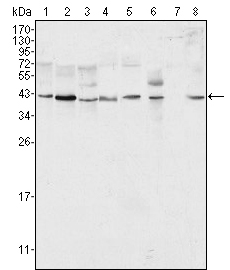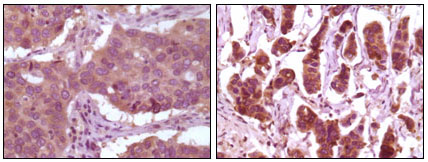ERK 2 Monoclonal Antibody
- Catalog No.:YM0245
- Applications:WB;IHC;IF;ELISA
- Reactivity:Human;Mouse;Monkey
- Target:
- ERK 2
- Fields:
- >>EGFR tyrosine kinase inhibitor resistance;>>Endocrine resistance;>>Platinum drug resistance;>>MAPK signaling pathway;>>ErbB signaling pathway;>>Ras signaling pathway;>>Rap1 signaling pathway;>>cGMP-PKG signaling pathway;>>cAMP signaling pathway;>>Chemokine signaling pathway;>>HIF-1 signaling pathway;>>FoxO signaling pathway;>>Sphingolipid signaling pathway;>>Phospholipase D signaling pathway;>>Oocyte meiosis;>>Autophagy - animal;>>mTOR signaling pathway;>>PI3K-Akt signaling pathway;>>Apoptosis;>>Cellular senescence;>>Adrenergic signaling in cardiomyocytes;>>Vascular smooth muscle contraction;>>TGF-beta signaling pathway;>>Axon guidance;>>VEGF signaling pathway;>>Apelin signaling pathway;>>Osteoclast differentiation;>>Focal adhesion;>>Adherens junction;>>Gap junction;>>Signaling pathways regulating pluripotency of stem cells;>>Platelet activation;>>Neutrophil extracellular trap formation;>>Toll-like receptor signaling pathway;>>NOD-like receptor signaling pathway;>>C-type lectin recep
- Gene Name:
- MAPK1
- Protein Name:
- Mitogen-activated protein kinase 1
- Human Gene Id:
- 5594
- Human Swiss Prot No:
- P28482
- Mouse Gene Id:
- 26413
- Mouse Swiss Prot No:
- P63085
- Immunogen:
- Purified recombinant fragment of human ERK 2 expressed in E. Coli.
- Specificity:
- ERK 2 Monoclonal Antibody detects endogenous levels of ERK 2 protein.
- Formulation:
- Liquid in PBS containing 50% glycerol, 0.5% BSA and 0.02% sodium azide.
- Source:
- Monoclonal, Mouse
- Dilution:
- WB 1:500 - 1:2000. IHC 1:200 - 1:1000. IF 1:200 - 1:1000. ELISA: 1:10000. Not yet tested in other applications.
- Purification:
- Affinity purification
- Storage Stability:
- -15°C to -25°C/1 year(Do not lower than -25°C)
- Other Name:
- MAPK1;ERK2;PRKM1;PRKM2;Mitogen-activated protein kinase 1;MAP kinase 1;MAPK 1;ERT1;Extracellular signal-regulated kinase 2;ERK-2;MAP kinase isoform p42;p42-MAPK;Mitogen-activated protein kinase 2;MAP kinase 2;MAPK 2
- Molecular Weight(Da):
- 41kD
- References:
- 1. Angelique W. Whitehurst, Fred L. Robinson, Mary Shannon Moore. J. Biol. Chem., Mar 2004; 279: 12840 – 12847.
2. N Hatano, Y Mori, M Oh-hora. Genes Cells, Nov 2003; 8: 847 - 856.
- Background:
- This gene encodes a member of the MAP kinase family. MAP kinases, also known as extracellular signal-regulated kinases (ERKs), act as an integration point for multiple biochemical signals, and are involved in a wide variety of cellular processes such as proliferation, differentiation, transcription regulation and development. The activation of this kinase requires its phosphorylation by upstream kinases. Upon activation, this kinase translocates to the nucleus of the stimulated cells, where it phosphorylates nuclear targets. One study also suggests that this protein acts as a transcriptional repressor independent of its kinase activity. The encoded protein has been identified as a moonlighting protein based on its ability to perform mechanistically distinct functions. Two alternatively spliced transcript variants encoding the same protein, but differing in the UTRs, have been reporte
- Function:
- catalytic activity:ATP + a protein = ADP + a phosphoprotein.,cofactor:Magnesium.,domain:The TXY motif contains the threonine and tyrosine residues whose phosphorylation activates the MAP kinases.,enzyme regulation:Activated by phosphorylation on tyrosine and threonine in response to insulin and NGF. Both phosphorylations are required for activity.,function:Involved in both the initiation and regulation of meiosis, mitosis, and postmitotic functions in differentiated cells by phosphorylating a number of transcription factors such as ELK1. Phosphorylates EIF4EBP1; required for initiation of translation. Phosphorylates microtubule-associated protein 2 (MAP2). Phosphorylates SPZ1 (By similarity). Phosphorylates heat shock factor protein 4 (HSF4) and ARHGEF2.,online information:Extracellular signal-regulated kinase entry,PTM:Dually phosphorylated on Thr-185 and Tyr-187, which activates the en
- Subcellular Location:
- Cytoplasm, cytoskeleton, spindle . Nucleus . Cytoplasm, cytoskeleton, microtubule organizing center, centrosome. Cytoplasm . Membrane, caveola . Cell junction, focal adhesion . Associated with the spindle during prometaphase and metaphase (By similarity). PEA15-binding and phosphorylated DAPK1 promote its cytoplasmic retention. Phosphorylation at Ser- 246 and Ser-248 as well as autophosphorylation at Thr-190 promote nuclear localization. .
- Expression:
- Brain,Epithelium,Lung,Platelet,T-cell,
- June 19-2018
- WESTERN IMMUNOBLOTTING PROTOCOL
- June 19-2018
- IMMUNOHISTOCHEMISTRY-PARAFFIN PROTOCOL
- June 19-2018
- IMMUNOFLUORESCENCE PROTOCOL
- September 08-2020
- FLOW-CYTOMEYRT-PROTOCOL
- May 20-2022
- Cell-Based ELISA│解您多样本WB检测之困扰
- July 13-2018
- CELL-BASED-ELISA-PROTOCOL-FOR-ACETYL-PROTEIN
- July 13-2018
- CELL-BASED-ELISA-PROTOCOL-FOR-PHOSPHO-PROTEIN
- July 13-2018
- Antibody-FAQs
- Products Images

- Western Blot analysis using ERK 2 Monoclonal Antibody against HeLa (1), NIH/3T3 (2), MCF-7 (3), HEK293 (4), Jurkat (5), A549 (6), NTERA-2 (7) and SMMC-7721 (8) cell lysate.

- Immunohistochemistry analysis of paraffin-embedded human lung carcinoma (left) and breast carcinoma (right) showing cytoplasmic localization with DAB staining using ERK 2 Monoclonal Antibody.

- Immunofluorescence analysis of Eca-109 cells using ERK 2 Monoclonal Antibody (green).



